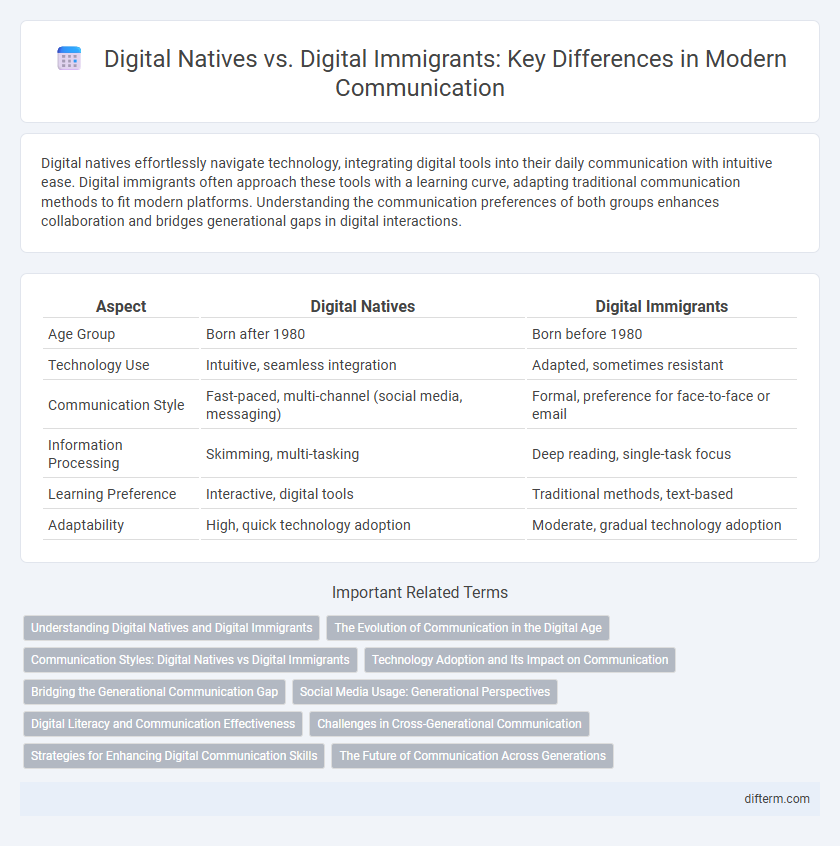Digital natives effortlessly navigate technology, integrating digital tools into their daily communication with intuitive ease. Digital immigrants often approach these tools with a learning curve, adapting traditional communication methods to fit modern platforms. Understanding the communication preferences of both groups enhances collaboration and bridges generational gaps in digital interactions.
Table of Comparison
| Aspect | Digital Natives | Digital Immigrants |
|---|---|---|
| Age Group | Born after 1980 | Born before 1980 |
| Technology Use | Intuitive, seamless integration | Adapted, sometimes resistant |
| Communication Style | Fast-paced, multi-channel (social media, messaging) | Formal, preference for face-to-face or email |
| Information Processing | Skimming, multi-tasking | Deep reading, single-task focus |
| Learning Preference | Interactive, digital tools | Traditional methods, text-based |
| Adaptability | High, quick technology adoption | Moderate, gradual technology adoption |
Understanding Digital Natives and Digital Immigrants
Digital natives, born into a world saturated with digital technology, naturally adapt to communication platforms like social media, instant messaging, and multimedia sharing. Digital immigrants, having acquired technology skills later in life, often prefer traditional communication methods such as emails and phone calls, while gradually integrating digital tools. Understanding these distinctions enhances communication strategies across generations by tailoring content delivery and interaction styles to digital fluency levels.
The Evolution of Communication in the Digital Age
Digital natives, born into the era of smartphones and social media, inherently navigate digital communication platforms with fluency, reshaping interpersonal interactions and information exchange. Digital immigrants, who adopted technology later in life, often rely on more traditional communication methods but gradually integrate digital tools to adapt to evolving communication landscapes. The evolution of communication in the digital age highlights a dynamic shift from analog to digital mediums, emphasizing immediacy, global connectivity, and multimedia content as defining features of contemporary discourse.
Communication Styles: Digital Natives vs Digital Immigrants
Digital natives prefer fast, visual, and interactive communication methods such as social media, instant messaging, and video calls, reflecting their fluency with digital technology from an early age. Digital immigrants tend to favor more traditional communication styles, including email, phone calls, and face-to-face interactions, often requiring more time to adapt to new platforms. These differing preferences influence workplace collaboration, learning environments, and social interactions, highlighting the importance of bridging communication gaps between generations.
Technology Adoption and Its Impact on Communication
Digital natives exhibit rapid technology adoption, seamlessly integrating emerging communication tools like instant messaging, social media, and video conferencing into daily interactions. Digital immigrants, however, often face a learning curve, adapting more slowly to new platforms, which affects their communication efficiency and style. The disparity in technology adoption reshapes communication dynamics, influencing information exchange speed, accessibility, and the overall digital literacy gap between generations.
Bridging the Generational Communication Gap
Digital natives, fluent in instant messaging and social media platforms, often prefer fast, visual communication, while digital immigrants tend to favor more traditional methods such as email or phone calls, creating a generational communication gap. Bridging this divide requires integrating user-friendly technologies with clear, inclusive communication strategies that accommodate varying digital proficiencies. Emphasizing empathy and continuous digital literacy training fosters mutual understanding and effective collaboration across generations.
Social Media Usage: Generational Perspectives
Digital natives, typically born after 1980, exhibit intuitive and immersive social media usage, seamlessly integrating platforms like Instagram, TikTok, and Snapchat into daily communication routines. Digital immigrants, born before 1980, often adopt social media platforms more cautiously, favoring Facebook and LinkedIn for maintaining professional and personal networks. This generational divide influences communication styles, with digital natives preferring fast, visual interactions and digital immigrants emphasizing structured, text-based exchanges.
Digital Literacy and Communication Effectiveness
Digital natives exhibit higher digital literacy, seamlessly navigating diverse communication platforms and adapting to evolving technologies, which enhances their communication effectiveness. Digital immigrants often face challenges in mastering digital tools, leading to potential misunderstandings and reduced efficiency in digital interactions. Bridging the digital literacy gap between these groups improves overall communication effectiveness across generational divides.
Challenges in Cross-Generational Communication
Digital natives, who have grown up with technology, often prefer fast, visual communication methods like texting and social media, which can create barriers for digital immigrants accustomed to face-to-face or telephone interactions. This generational divide leads to misunderstandings and slower adoption of digital tools by older adults, impacting workplace collaboration and social connectivity. Bridging this gap requires tailored communication strategies that respect both generations' preferences and technological fluency.
Strategies for Enhancing Digital Communication Skills
Digital natives excel in intuitive technology use but benefit from structured training to enhance critical evaluation of online information and professional communication. Digital immigrants require continued learning focused on adapting to new platforms and understanding digital etiquette to bridge generational gaps effectively. Implementing tailored workshops and interactive simulations improves overall digital communication competence across diverse age groups.
The Future of Communication Across Generations
Digital natives, born into technology-rich environments, naturally adapt to instant messaging, social media, and multimedia communication, shaping the future of cross-generational interaction. Digital immigrants, having adapted later in life, prefer traditional communication methods but gradually integrate digital tools, fostering hybrid communication styles. Bridging these generational communication preferences will drive innovative platforms and inclusive technologies that enhance connectivity and collaboration.
digital natives vs digital immigrants Infographic

 difterm.com
difterm.com